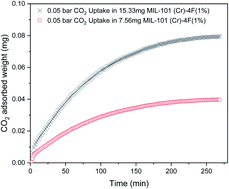Fluorinated MIL-101 for carbon capture utilisation and storage: uptake and diffusion studies under relevant industrial conditions†
Abstract
Carbon capture utilisation and storage (CCUS) using solid sorbents such as zeolites, activated carbon and Metal–Organic Frameworks (MOFs) could facilitate the reduction of anthropogenic CO2 concentration. Developing efficient and stable adsorbents for CO2 capture as well as understanding their transport diffusion limitations for CO2 utilisation plays a crucial role in CCUS technology development. However, experimental data available on CO2 capture and diffusion under relevant industrial conditions is very limited, particularly for MOFs. In this study we explore the use of a gravimetric Dynamic Vapour Sorption (DVS) instrument to measure low concentration CO2 uptake and adsorption kinetics on a novel partially fluorinated MIL-101(Cr) saturated with different water vapour concentrations, at ambient pressure and temperature. Results show that up to water P/P0 = 0.15 the total CO2 uptake of the modified material improves and that the introduction of small amounts of water enhances the diffusion of CO2. MIL-101(Cr)-4F(1%) proved to be a stable material under moist conditions compared to other industrial MOFs, allowing facile regeneration under relevant industrial conditions.



 Please wait while we load your content...
Please wait while we load your content...